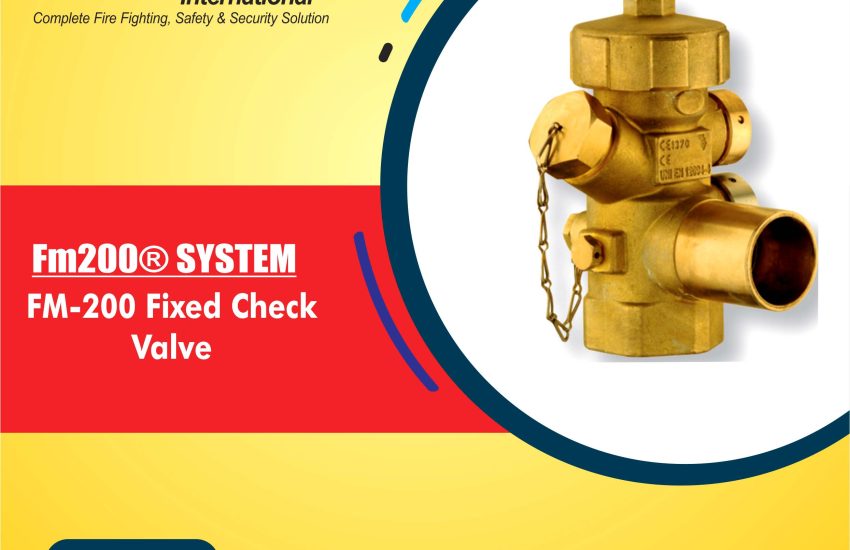FM-200 Fixed Check Valve is a critical component in FM-200 fire suppression systems. It regulates the flow of the agent during discharge, ensuring efficient and effective fire suppression. In this guide, we’ll explain the FM-200 fixed check valve, its features, benefits, installation steps, and maintenance tips.
What is FM-200 Fixed Check Valve?
FM-200 Fixed Check Valve is designed for FM-200 clean agent systems. It plays an important role in controlling the direction of the flow of FM-200 agent. By preventing reverse flow, the valve helps maintain the system’s integrity and effectiveness. Consequently, the agent only flows in the desired direction, ensuring proper discharge during emergencies.
Key Features of FM-200 Fixed Check Valve:
- Reliable Operation: The valve ensures a one-way flow, guaranteeing that the FM-200 agent travels in the correct direction.
- Durability: Made from corrosion-resistant materials, the valve withstands harsh conditions, ensuring long-term reliability.
- Easy Installation: Its simple design allows for quick and easy installation, reducing both setup time and costs.
- Compatibility: This valve works seamlessly with FM-200 systems and other clean agent systems, making it suitable for various fire protection applications.
Benefits of FM-200 Fixed Check Valve
1. Prevents Reverse Flow
The primary function of the FM-200 fixed check valve is to prevent reverse flow. This ensures that FM-200 only moves in the correct direction, which helps maintain the system’s efficiency and effectiveness.
2. Ensures Proper Discharge
The valve ensures that the FM-200 agent is discharged properly when needed. In case of fire, the valve guarantees that the agent reaches the designated areas to effectively suppress the fire, minimizing damage.
3. Increases System Reliability
By preventing reverse flow, the valve enhances the overall reliability of the system. It ensures consistent discharge, minimizing the risk of system malfunctions during emergencies.
4. Cost-Effective Maintenance
Thanks to its durable and corrosion-resistant construction, the FM-200 fixed check valve requires minimal maintenance. This reduces both replacement and upkeep costs over time, making it a cost-effective choice for your fire suppression system.
5. Environmentally Safe
FM-200 is a clean agent that is non-ozone-depleting. The valve ensures that the FM-200 system operates efficiently, helping to minimize environmental impact during its use.
Installation of FM-200 Fixed Check Valve
Proper installation of the FM-200 check valve is crucial for the system’s performance. Here’s how to install the valve step by step:
1. System Evaluation
Before installing the valve, assess your FM-200 fire suppression system. Carefully consider the most effective placement of the valve to control the agent flow properly.
2. Determine Valve Placement
Place the check valve between the FM-200 cylinder and the discharge piping. This strategic placement ensures the agent only flows in the correct direction, preventing backflow that could hinder the system’s performance.
3. Mount the Valve
Once you’ve determined the ideal placement, mount the FM-200 check valve securely using the appropriate brackets. This will prevent any movement or damage during operation.
4. Check Valve Orientation
Ensure that the valve is oriented correctly. Most check valves have arrows to indicate the proper flow direction. Installing it in the correct orientation guarantees the agent will flow in one direction.
5. Connect the Piping
After positioning the valve, securely connect the piping to both the FM-200 cylinder and the discharge system. Ensure all connections are tight to avoid any potential leaks.
6. System Testing
Once installation is complete, test the system. Confirm that the check valve functions properly and that FM-200 agent flows in the correct direction without reverse flow.
Maintenance Tips for FM-200 Fixed Check Valve
1. Regular Inspections
Regularly inspect the FM-200 check valve for signs of wear or damage. Inspect the valve for dirt or debris that might obstruct the flow of the agent. Early detection of issues will help avoid larger problems.
2. Clean the Valve
To ensure optimal performance, clean the valve periodically. Accumulated dirt or debris inside the valve can block the flow of the agent, reducing the system’s effectiveness. A simple cleaning process keeps the valve in good working condition.
3. Check for Leaks
Inspect all connections for leaks. Even small leaks can decrease the efficiency of the FM-200 system. If you notice any leaks, tighten the connections or replace seals to prevent further issues.
4. Test the Valve
Test the valve periodically to verify that it’s working as expected. A functioning check valve allows one-way flow and prevents reverse flow, which is essential for system reliability.
5. Professional Servicing
To ensure the FM-200 fire suppression system remains in top condition, schedule regular professional servicing. Certified technicians can thoroughly inspect the entire system, including the check valve, and make necessary adjustments or repairs.
Choosing the Right FM-200 Fixed Check Valve
When choosing an FM-200 check valve, consider the following factors:
- Material: Opt for a valve made from corrosion-resistant materials to ensure long-term durability and performance.
- Valve Size: The valve size should be compatible with your FM-200 fire suppression system. This ensures the flow rate remains optimal for the system.
- Compatibility: Confirm that the valve is compatible with other components in the FM-200 system, such as cylinders and discharge pipes.
- Pressure Rating: Ensure that the valve is rated for the correct pressure to handle the flow of the FM-200 agent without causing any issues.
Conclusion
FM-200 Check Valve is an essential component in any FM-200 fire suppression system. It plays a crucial role in regulating the flow of the FM-200 agent and ensuring that the agent flows in the right direction during a fire emergency. With its reliable performance, durability, and minimal maintenance requirements, this valve provides long-term protection and reliability.


